#euprymna berryi
Text
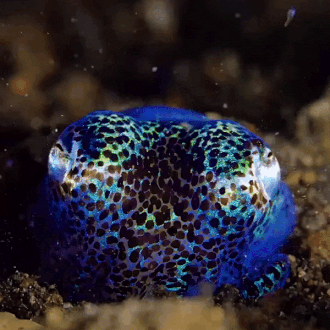
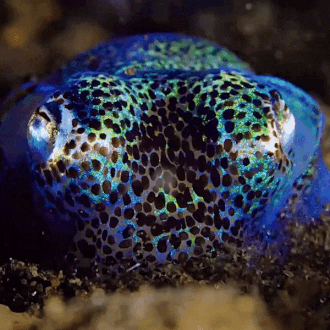
the hummingbird bobtail squid (euprymna berryi) | source
#stim#squids#cephalopods#bobtail squids#sfw#blue#green#black#white#brown#sea creatures#marine life#underwater#animals#bioluminescence#stubby squids#hummingbird bobtail squid#euprymna berryi#tentacles#nature#ishy gifs#postish
1K notes
·
View notes
Photo

Vessel sound is temporarily causing hearing loss in squids
Globally, anthropogenic sounds have become louder and more persistent, however, little is known about how invertebrates detect and respond to human-made sound. Now, new research shown noise associated with boats causes causes temporal hearing loss in squids across different stages of their life cycle.
The hummingbird bobtail squid (Euprymna berryi) has a short lifespan of at least 6 months, which make them a convenient animal for lab studies. Hearing and behavioural observations were made by researchers before, during and after 15 minutes of vessel sound playback, to test how these squids react to noise pollution, and noted that these squids decrease their hearing sensitivity after exposure to noise, and particularly noise affected juveniles. Juvenile squids experienced an important hearing loss sensitivity after noise exposure between 400 and 800 Hz, while adult and mature squids decreased their sensibility after 200 to 600 Hz exposure, showing more resistence. All squids recovered auditory sensitivity within two hours.
Researchers aim the inclusion of cephalopods within management and policy, because anthropogenic activities and associated sound levels in the ocean are increasing, while the role sound plays in cephalopod life history is only just beginning to be understood.
Photo by Pascal Girard
Reference () Putland et al. 2023. Vessel sound causes hearing loss for hummingbird bobtail squid (Euprymna berryi). Frontiers in Marine Science
#Euprymna berryi#hummingbird bobtail squid#science#biology#marine conservation#conservation#sciblr#scienceblr#bioblr#biologyblr#marine biology
325 notes
·
View notes
Text
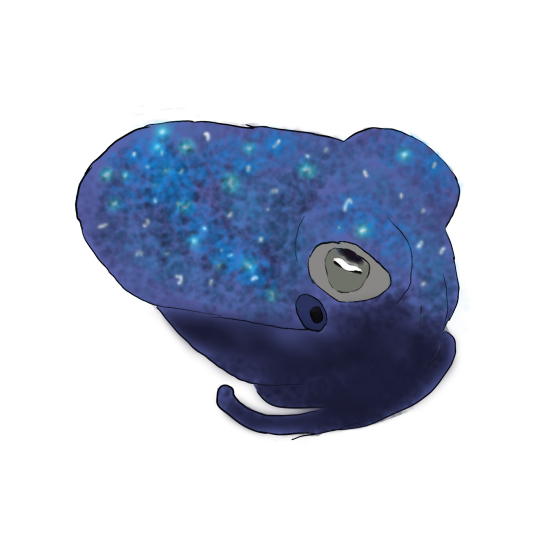
Hummingbird bobtail squid
4 notes
·
View notes
Text
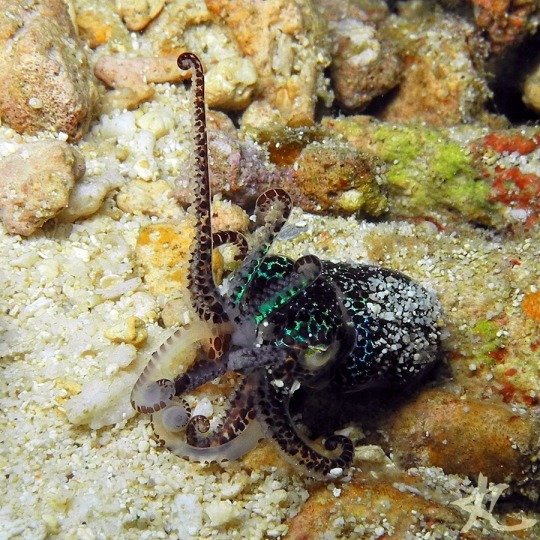
Daily Cephalopod #155
#squid#the hummingbird bobtail squid 💙#or euprymna berryi#daily cephalopod#cephalopod#marine life#ocean creatures#ocean critters#marine biology#zoology#animals#biology#cephalopods#marine animals
623 notes
·
View notes
Text
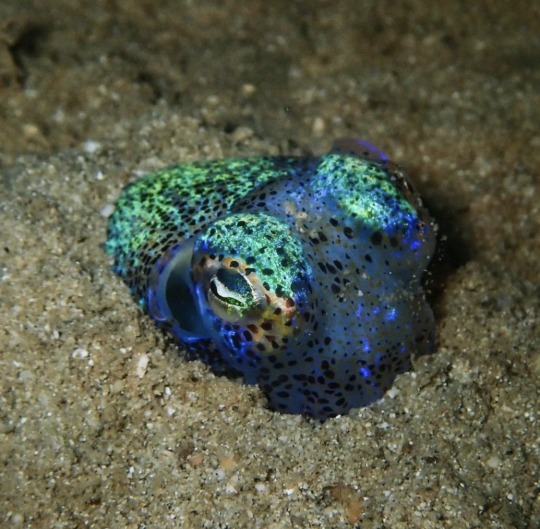

Euprymna berryi
what if we were both hummingbird bobtail squid and you saw my globular eyes peeking out of the sand and you told me i was the most beautiful babe in the whole benthic zone and we danced the night away and then you woke up in a cold sweat facedown in a Wendy’s parking lot wearing a michelin man costume. what would you do then
#squid squaturday#cephalopod saturday#cephalopods#marine biology#squid#bobtail squid#week 31#what a finale
249 notes
·
View notes
Video
Hummingbird Bobtail Squid | Euprymna berryi
“During the day, the hummingbid bobtail squid remains most of the time buried in the sand, coming out at night to capture small crustaceans, which it hunts using a bioluminescent organ in its gill cavity.” (Source)
#Hummingbird Bobtail Squid#Hummingbird#Bobtail#Squid#Euprymna berryi#saltwater#ocean#sea#marine#underwater#undersea#nature#aquatic#aquaria#cephalopod#aquatic photography
103 notes
·
View notes
Photo

Bobtail squid (Euprymna berryi)
67 notes
·
View notes
Photo

Hello angel!! Umm I did not know that magnificent creature existed so thank you so much for the request, I am in love!!!!!
@5657-34543-6767
24 notes
·
View notes
Note
hi! I'm not sure if you've posted about it before, but the rainbow bobtail squid is one of my favorite invertebrates!

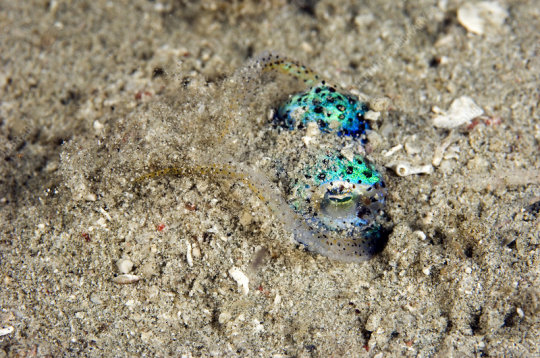
Hummingbird bobtail squid | Euprymna berryi
Some other common names: rainbow bobtail squid, berry's bobtail squid
Image credit: x, x
#boras posts#salt#squid#fishblr#fish photography#marine life#theyre so pretty omg?? ive never heard of these guys before#i adore them... little cuties#ask#request
2K notes
·
View notes
Photo
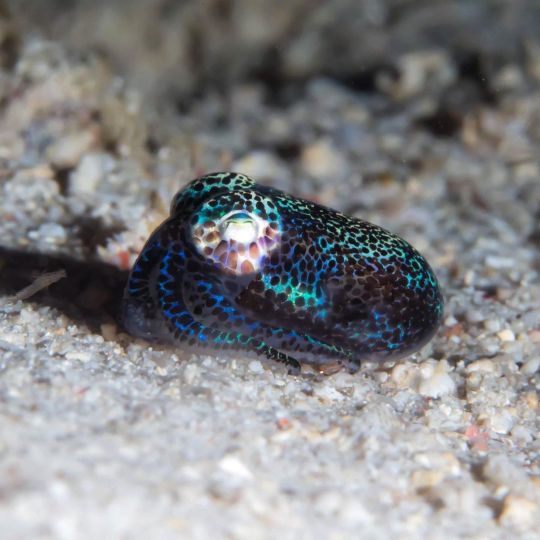
The hummingbird bobtail squid (Euprymna berryi) is here to dazzle you in blue! Its striking color comes from pigment-holding cells called chromatophores distributed throughout its body. This cephalopod lives in Indo-Pacific waters, inhabiting the ocean floor where it burrows beneath sand to rest or hide when under threat. It’s a tiny squid: males only reach sizes of about 1.2 inches (3 centimeters), while females grow up to 2 inches (5 centimeters). Photo: Rickard Zerpe, CC BY 2.0, flickr https://www.instagram.com/p/CMKTFqgAKqw/?igshid=5r4p4irsikbn
866 notes
·
View notes
Note
🖍
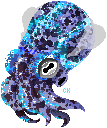
Euprymna berryi! Hummingbird Bobtail Squid!
These little guys have So Much going on in spite of being So TINY
#They are TEENY TINY and yet made entirely out of iridescent TV static#.Replies#Voidix#CK's art#Pixelart
13 notes
·
View notes
Note
ocean fact: Euprymna berryi are adorable bobtail squid and have a symbiotic relationship with glowy bacteria which change their glowiness to match the light coming down from the surface of the ocean
they fucking glow???? thats so cool i want to be one
1 note
·
View note
Photo

Bioluminescent Bobtail Squid
This adorable little creature is one of over 70 cephalopod species known collectively as bobtail squid (sometimes called dumpling or stubby squid). They belong to the order Sepiolida and are closely related to the cuttlefish (order Sepiida). Although the squid closely resemble their cousins and swim in the same manner (jet propulsion or using the fins on their mantle), they do not have a cuttlebone, but, like all other cephalopods, possess a distinctive head, arms and/or tentacles (which are actually a modified form of the molluscan foot observed in snails), bilateral symmetry and the ability to squirt ink.
The bobtail squid is small; the mantle (the winged body section that lies above the head) of a typical male measures between 1-8 cm long. They inhabit the shallow, coastal waters of the Pacific and Indian Oceans, as well as the western coast of the Cape Peninsula off of South Africa.The Humming-bird or Berry’s bobtail squid (Euprymna berryi) in the picture is found in the waters off of East Timor and measures ~3-5 cm. The brilliant colouration comes from special cells known as chromatophores, which are pigmented light-reflecting cells, controlled by muscular action.
Bobtail squid have a symbiotic relationship with a bioluminescent bacteria (Vibrio fischeri) that live within a special light organ in the squid’s mantle. In exchange for sugars and amino acids, the bacteria filter the outgoing bioluminescence so that the squid’s mantle (when viewed from below) is the same shade as the light that hits the top of the mantle. In other words, they give the squid an 'invisibility cloak'. This symbiotic relationship begins from the moment the squid hatches, and its maturity is dependent on morphological changes induced by bacterial colonisation.
YK Image credit: By Nick Hobgood, 2005 (http://commons.wikimedia.org/wiki/File:Bobtail_squid.jpg). Used under the creative commons license.
Further reading: Bobtail squid (includes some good videos) -http://bit.ly/1w63lhV More about the bioluminescent bacteria -http://bit.ly/1xoh709 & http://bit.ly/1Ao3I9m &http://bit.ly/1wMfjca Cephlapod chromatophores (warning - large PDF! Very comprehensive teaching guide with educational activities) http://www.thecephalopodpage.org/cephschool/HowCephalopodsChangeColor.pdf
#Bobtail squid#animal#wildlife#bioluminescent#bioluminescence#science#bacteria#squid#cephalopod#the earth story#ocean#biology#chromatophore
584 notes
·
View notes
Note
may i request some bobtail squids🥺 they're so littol and cute and

Daily Cephalopod #76
#squid#the hummingbird bobtail squid 💙#berry bobtail squid#or euprymna berryi#daily cephalopod#squid mail くコ:彡#GOOBERS!!!#cephalopod#marine life#ocean creatures#ocean critters#marine biology#zoology#animals#biology#cephalopods#marine animals
603 notes
·
View notes
Photo


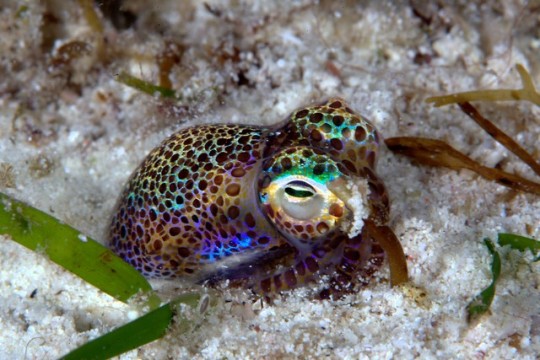
The hummingbird bobtail squid (Euprymna berryi), also known as Berry’s bobtail squid, is a small species of cephalopod that is found throughout the tropical waters of the central Indo-Pacific area from the Indonesia to the Philippines. Males usually measure no more than one inch in length, though females can grow to twice that size. These squid spend most of their time on the sea floor buried in sand, either hiding from danger or resting during the day. At night, it hunts small crustaceans living in the sand.
(Photo credit: Jack, Nick Hobgood, Klaus Stiefel)
326 notes
·
View notes
Photo

Blue (Berry's) bobtail squid by Diverjane
0 notes